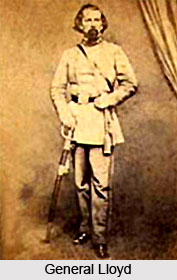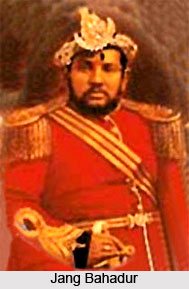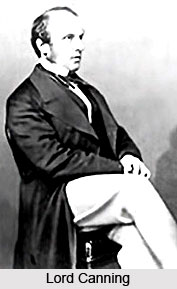 Reports of the terrible fate of the English men and women who had been besieged by the rebels at Kanhpur (present day Kanpur, Uttar Pradesh) had reached Calcutta early in July. But it was not until Havelock telegraphed on 17th July, the account of his victory, and of their murder, that all hope of their survival vanished. Then, for a moment, the crushing blight of hopelessness succeeded to the agony of suspense. Lord Canning had, in the last days of July, sanctioned the raising of a corps of yeomanry cavalry in Calcutta. It was a corps which, led by a very able officer, Major J. F. Richardson, was destined to render excellent service. He had, further, in alignment with the Lieutenant-Governor of Bengal, directed similar enlistments from the unemployed sailors to meet the hassles then threatening in Bengal and Bihar. He had concluded an arrangement with Jang Bahadur, Prime Minister and virtual ruler of the State of Nepal, for the despatch of a body of Gurkha troops to the districts of Gorakhpur and Azamgarh.
Reports of the terrible fate of the English men and women who had been besieged by the rebels at Kanhpur (present day Kanpur, Uttar Pradesh) had reached Calcutta early in July. But it was not until Havelock telegraphed on 17th July, the account of his victory, and of their murder, that all hope of their survival vanished. Then, for a moment, the crushing blight of hopelessness succeeded to the agony of suspense. Lord Canning had, in the last days of July, sanctioned the raising of a corps of yeomanry cavalry in Calcutta. It was a corps which, led by a very able officer, Major J. F. Richardson, was destined to render excellent service. He had, further, in alignment with the Lieutenant-Governor of Bengal, directed similar enlistments from the unemployed sailors to meet the hassles then threatening in Bengal and Bihar. He had concluded an arrangement with Jang Bahadur, Prime Minister and virtual ruler of the State of Nepal, for the despatch of a body of Gurkha troops to the districts of Gorakhpur and Azamgarh.
So far Major Richardson had done well. But none of those acts, applaudable as they were, touched the crucial point. They did not provide immediate relief to Havelock. Yet at that moment, besides the 53rd, which garrisoned in Fort William, there was a wing of the 37th regiment available. The 10th foot garrisoned in Danapur. While on 5th July, two days before Havelock started from Allahabad on his memorable campaign, the 5th Fusiliers, 800 strong, landed in Calcutta from Mauritius.
The water line between Calcutta and Allahabad, approximately 664 miles in length, had one weak middle point at Danapur and Patna, two places only twelve miles apart. Danapur was 344 miles from Calcutta, Patna was twelve miles nearer to the capital. At Danapur there were three native regiments - the 7th, 8th, and 40th N. I., one company of European, one of native artillery, and the 10th foot. The position of the two places was a most important one. The province, Western Bihar, of which Patna was the capital, was one of the richest provinces in India. It contained a substantial number of native landowners, men of large estates and ancient lineage. English merchants, too, had invested large sums in the province in the cultivation of indigo, one of its staple exports. It touched on the one side, to the north-west, the revolted districts of Ghazipur, Azamgarh, Juanpur, and Mirzapur. To the north, it touched Nepal, to the east, the division of Eastern Bihar. Eastern Bihar was not only inflammable itself, but also open to assault by the sipahis (soldiers) in Eastern Bengal, then in a state of budding mutiny.
 It was, then, of paramount importance that the division of Western Bihar, the middle piece between Calcutta and Allahabad should be preserved from immediate outburst. The Kanpur province had been preserved from revolt by the brisk measures taken by its Commissioner, William Tayler. Harassed by the finicky interference of his superior at Calcutta, Frederick Halliday, Tayler had, nonetheless, with resources he had made for himself, put down insurrection in the most inflammable city in India. Kanpur was the headquarters of the intriguing Wahabis. Tayler had preserved, amid great difficulties, complete order in the districts, including those of Patna, Gaya, Shahabad, Saran, Champaran, and Tirhut, which went to make up the division of which he was the pro-consul.
It was, then, of paramount importance that the division of Western Bihar, the middle piece between Calcutta and Allahabad should be preserved from immediate outburst. The Kanpur province had been preserved from revolt by the brisk measures taken by its Commissioner, William Tayler. Harassed by the finicky interference of his superior at Calcutta, Frederick Halliday, Tayler had, nonetheless, with resources he had made for himself, put down insurrection in the most inflammable city in India. Kanpur was the headquarters of the intriguing Wahabis. Tayler had preserved, amid great difficulties, complete order in the districts, including those of Patna, Gaya, Shahabad, Saran, Champaran, and Tirhut, which went to make up the division of which he was the pro-consul.
William Tayler had, towards the end of June, sensed the arrival one possible danger to the province. That danger would be very great if the sipahis at Danapur, numbering nearly 3000, were to break out in revolt. If the Government would order that they should be disarmed all would go well. For that he would answer.
The opinion of Tayler on this point was also the opinion of all intellectual men in Calcutta. It was the opinion, in fact, of everyone who was not a secretary to Government, or who hoped, by opportunistic measures and servility, to become a secretary to Government. The question had been debated at an earlier period. The reply of the Government then had been that, with only a sufficient number of European troops to preserve order close to the capital, it did not feel justified in proceeding to any immediate measures. Unless there were sufficient white troops on the spot, the circumstances might precipitate the evil it was intended to heal. That answer sufficed for the moment. But the 37th had started. Preparations were in the pipeline to despatch the 5th Fusiliers, in steamers which should pass Patna and Danapur. It was felt that the time had arrived when the disarming process might be carried out in a successful manner, under circumstances which would render resistance impossible.
Amidst umpteen rumours that Lord Canning was not acting in his own intelligence, that he was being governed by his consul-generals, Sir Patrick Grant and Frederick Halliday, local population of traders had other plans in mind. It was felt, then, that the time had arrived when the leading members of the mercantile community, the proprietors of indigo factories, who had large interests in Western Bihar, should ask to be allowed to make a personal appeal to Lord Canning. They made a request to this effect on the 17th of July. Lord Canning agreed to receive them on the 20th.
He did receive a delegation from them on that date. He listened to their statements, heard from their mouths that the disarming of the native regiments at Danapur was the one measure necessary to restore public confidence in Bihar. A favourable opportunity now presented itself for the carrying out of such a measure. The 5th Fusiliers, which had quitted Calcutta by steamer on the 12th, would reach Danapur around the 22nd. The disarming could then be accomplished in two hours. Lord Canning listened to them without interrupting them, and replied curtly, that he would not comply with their request.
 The native troops in Bengal and in the North-west Provinces of India had generally mutinied or had been disarmed. At Danapur, 12 miles from the inflammable city of Patna, the centre of the richest province in India, were three native regiments still carrying their arms. Havelock was desperate to receive reinforcements at Kanhpur (Kanpur). The arrival at Kanhpur (Kanpur) of such reinforcements depended on the continued serenity of the middle piece of country of which Danapur and Patna were the centres. The continued serenity of that middle piece could only be ensured by the immediate disarming of the three native regiments at Danapur.
The native troops in Bengal and in the North-west Provinces of India had generally mutinied or had been disarmed. At Danapur, 12 miles from the inflammable city of Patna, the centre of the richest province in India, were three native regiments still carrying their arms. Havelock was desperate to receive reinforcements at Kanhpur (Kanpur). The arrival at Kanhpur (Kanpur) of such reinforcements depended on the continued serenity of the middle piece of country of which Danapur and Patna were the centres. The continued serenity of that middle piece could only be ensured by the immediate disarming of the three native regiments at Danapur.
William Tayler had been able to preserve order at Patna and throughout his division with utmost difficulty, and by the display of the rarest qualities of daring statesmanship. He had put down an uprising in the city itself, had baffled the plottings of the Wahabi leaders, had instilled fear and discouragement in the ranks of the insurgents, and by his magnificent example had given assurance to his subordinates.
It would serve no good use to dwell at length upon the incapable action which threw the middle piece between Calcutta and Kanhpur (Kanpur) into a condition of unequalled disorder. This incapability delayed the advance of the troops for which Havelock was waiting with bated breath. Under the weight of the responsibility thrust upon him, General Lloyd oscillated like the pendulum of a clock. When, on the 22nd, the main body of the 5th Fusiliers arrived off Danapur, he would not order them to disembark. Two days later, when two companies of the 37th reached the station, the General ordered them to land. The day following, the 25th, he concluded not to disarm the sipahis, but to deny them of the percussion caps which had been served out to them, and of those in the magazine.
By a display of force General Lloyd succeeded in securing the caps in the magazine. Then, believing he had hit a feat, he dismissed the European troops, and went comfortably for his lunch. But when an hour or two later the officers, by his direction, strove to persuade the sipahis (soldiers) to surrender the caps, the latter broke into open mutiny. The rebels went off towards the Son River, in the direction of Arah. The European troops were at once called out, but there was no one present to give any orders. The General had gone on board of one of the steamers. In the matter of taking upon themselves the smallest responsibility in his absence, the two officers next in command took example from the Government of India. Nothing, or next to nothing, was done. The mutineers got off without being penalised. It was one of the most painful incidents of those troubled times.
Nor was the calamity confined to Danapur only. The telegraph did its work. The very evening of the day on which these events occurred, the troopers of the 12th irregulars rose in mutiny and murdered their commanding officer and his wife. There was every possibility that, unless the British should take prompt action, the whole of Western Bihar would go ablaze.
The rebel native soldiers, amazed at being allowed to escape without pursuit, reached the banks of the Son on the early morning of the 26th. For want of boats in which to cross they were delayed there till the evening. Then, having received most comforting assurances from Kunwar Singh, a large landowner, they were conveyed to the western bank. They then marched to Arah, released the prisoners from the jail, plundered the treasury, and set out to hound for the Europeans.



















